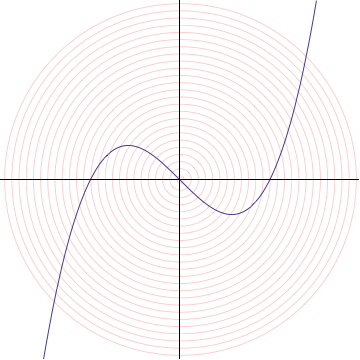Taking "Zooming in on a point of a graph" seriously
An animation of your first example, $y=x(x−1)(x+1)$. I limited the number of frames so that the file would not be too huge (it is ~1MB now). Frame rate is browser and processor dependent. At best this gives an idea of what a more professional animation might look like.

In algebraic geometry, this construction is known as the tangent cone to the graph. More generally, suppose we have the zero set of any polynomial $f(x,y) = 0$, and assume $f(0,0)=0$. Then we can write
$f(x,y) = a_m (x,y) + a_{m+1}(x,y) +a_{m+2}(x,y) +\cdots$
where $a_i(x,y)$ is a homogeneous polynomial of degree $i$ and $a_m$ is nonzero. The zero set of $a_m$ is called the tangent cone to the curve at the origin. It is a product of $m$ linear forms (over $\mathbb{C}$), and $m=1$ exactly when the zero set is smooth at the origin. In this case, the tangent cone coincides with the tangent space.
From your point of view, when we substitute $x\mapsto x/c$ and $y\mapsto y/c$ it is clear that the term left in the limit is $a_m$.
We can of course find tangent cones at other points of the zero set by changing coordinates.
In general, for a smooth function $f$ you should be able to take a multivariate Taylor expansion and read off the tangent cone from the lowest degree part. This is where the difficulty comes in for actually defining the tangent line in terms of the tangent cone in a calculus class, as computing the Taylor expansion demands we already have a notion of derivative. This difficulty is obviously not seen in the case of polynomials, although recentering the Taylor expansion of a polynomial at a different point is perhaps easiest done with the aid of derivatives.
Higher dimensional analogues are also available without any real work, although in the singular case the tangent cone is much more interesting than just a union of hyperplanes: it will be a cone over some variety. The homogeneous polynomial $a_m(x_1,\ldots,x_n)$ typically doesn't factor into a product of linear forms when $n>2$.
Tangent cones are treated in any reasonable introduction to algebraic geometry, such as Harris' "First course" book or Shafarevich.
I haven't seen any Calculus books take this approach. Possibly, this is because it is not clear how to proceed in the case of functions that are not polynomials. Consider even the really nice function $y = e^x$ and say you are interested in the tangent line to the graph at (0,1).
Using your scheme and the fact that $e^{a+b} = e^a\cdot e^b$, one writes $\frac{y-1}{c} = e^\frac{x}{c}$. This leaves us with
$$ y = 1 + c \cdot e^\frac{x}{c} $$
While taking the limit as $c \to \infty$ certainly gives the correct answer $y = 1+x$, I am not sure how to actually compute this limit without using either Taylor series or L'Hospital's rule, both of which already require you to know the derivative of $e^x$.
Of course you will run into similar difficulties if you try to compute the derivative of this function from the limit-based definition directly. If I remember correctly, standard textbooks on Calculus get around this annoyance either by declaring the answer without proof or by using implicit differentiation and $\ln(y) = x$. It is not too difficult to obtain the derivative of the natural log function from first principles.